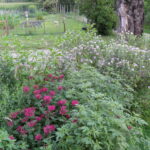Atlantic White Cedar (AWC) is a pioneer species with typical longevity of 200 to 300 years. However, in New Jersey AWC is only found in six counties and has lost about two-thirds of its acreage since the state began to be settled. Currently, there is only about 40,000 acres of AWC forest remaining in the state.
The decline in AWC over the past few decades has been linked to climate change related issues. AWC forests that are close to NJ’s coasts are dying due to sea-level rise as salt water encroaches into AWC swamps kills the trees due to their salt-intolerant roots. Away from the coastal areas into the NJ Pinelands the tree’s ability to survive and regenerate has also been impacted by increased flooding as a result of climate change, as well as herbivory from overabundant white-tailed deer populations that feed on new seedlings. Additionally, the Atlantic White-Cedar Ecology and Best Management Practices Manual (Mylecraine & Zimmermann 2000) also lists fire suppression and poor post-harvest management as additional factors in the decline of AWC. Eliminating fire on the landscape prevents AWC from invading patches occupied by other species and causes AWC forests to be lost due to natural succession. A lack of proper post-harvest management, like poor competition control, results in AWC, a subclimax species, being replaced by climax hardwood species (red maple for example). “In the past, historically cedar certainly could regenerate itself after a major disturbance, like fire, windstorm, or hurricane,” said Bob Williams, a NJ Forester, “Today that does not happen so often. When these disturbances happen other species already have a competitive edge.” However, all these issues could be mitigated using ecological-based forest stewardship and prevent AWC from further decline.

The Federally Endangered Swamp Pink lily which inhabits Atlantic White Cedar forests in southern NJ. Photo by Kristen Meistrell
The decline in AWC forests has impacted not only critical wildlife habitat and conditions suitable for the survival of some rare plant species, including the Federally Endangered Swamp Pink lily, but the loss of AWC also impacts water quality. AWC swamps act as filters and stormwater holding areas, which as they are released helps regulate hydrology in the region.
To address the issue of AWC decline, NJ is implementing a NJ AWC Wetland Ecosystem Restoration Plan (4/2020) as prepared by the New Jersey Department of Environmental Protection/New Jersey Forest Service to restore 10,000 to 20,000 acres of AWC over the next 10 years.
New Jersey Audubon supports this ambitious effort and is working with private landowners in the Pinelands to develop and implement Forest Stewardship Plans on their property to manage for the health of AWC and other species that rely on this habitat type.

NJA Staff planting Atlantic White Cedar seedlings at Lee Brothers Cranberry property ,2021 Photo by John Parke
In April 2021, with a grant from the Arbor Day Foundation, NJA Stewardship Department staff, with assistance from Pine Creek Forestry, began reforestation efforts of AWC in the Pinelands on two large cranberry farms that have been addressing this decline with active forest management under their State and Pinelands Commission approved Forest Stewardship Plans. “We have been engaged in forest stewardship for the better part of 25 years, with the assistance of our Forester,” said Stephen Lee, IV a sixth-generation cranberry farmer of Lee Brothers, Inc. and have learned that “unless we begin to be strategically aggressive, in terms of how to actively manage the land, that’s when you are going to see true conservation.”
NJA planted 2,500 AWC seedlings at the Lee Brothers Cranberry Farm and is scheduled to plant an additional 7,500 AWC seedlings at Pine Island Cranberry Co. this Fall 2021. 

Of special note, the plight of Atlantic White Cedar is currently the focus of nationally acclaimed American designer and sculptor Maya Lin. Lin’s Ghost Forest exhibit is currently on display at Madison Square Park in Manhattan, NY. According to Madison Square Park’s website, “Maya Lin’s Ghost Forest, a towering stand of forty-nine haunting Atlantic white cedar trees, is a newly-commissioned public art work. Lin brings her vision as an artist and her agency as an environmental activist to this project, a memory of germination, vegetation, and abundance and a harsh symbol of the devastation of climate change. The height of each tree, around forty feet, overwhelms human scale and stands as a metaphor of the outsized impact of a looming environmental calamity. In nature, a ghost forest is the evidence of a dead woodland that was once vibrant. Atlantic white cedar populations on the East Coast are endangered by past forestry practices and threats from climate change, including extreme weather events that yield saltwater intrusion, wind events, and fire. The trees in Ghost Forest were all slated to be cleared as part of regeneration efforts in the fragile ecosystem of the Pine Barrens of New Jersey. The magnitude of planetary vulnerability is a significant subject in Lin’s practice through sculpture, installation, and her web-based resource, What Is Missing?. Now two generations removed from the Earthwork artists of the 1960s and 1970s, Lin is taking on rural and urban outdoor space with a focus on geology and the fragility of the earth’s ecosystems.”








